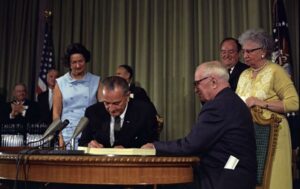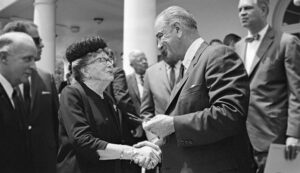As May draws to a close and we wrap up Older Americans Month, we are pleased to feature the following blog by Kathy Greenlee, a global authority in the field of aging and the former U.S. Assistant Secretary for Aging. Her post underscores the importance of persistent advocacy and enhanced funding for crucial programs supporting older adults.
On July 30, 1965, President Lyndon Johnson signed the Medicare and Medicaid legislation into law. The setting was the Truman Presidential Library in Liberty, Missouri. President Harry Truman witnessed the signing and was enrolled as the first Medicare beneficiary on the spot. From the outset, Medicare and Medicaid have captured the limelight and the nation’s attention. Passing the legislation was a hard-fought battle.

Two weeks earlier, on July 14, 1965, President Johnson signed the Older Americans Act (OAA) into law. The President is seen handing a signing pen to an older woman at the White House event. Historically, the OAA has garnered less attention. It is best known as one of President Johnson’s Great Society programs.

Nearly 60 years later, it is important to couple the three programs to understand their purpose and relative importance to older people in this country. Medicare = healthcare. Medicaid = the primary source of funding for long term care. OAA = services to support independence.
I have worked for more than two decades at the intersection of public policy designed to support the independence of older people and people with disabilities of all ages. Independence and choice are the hallmarks of those efforts. And, over time, an increasing number of us have advocated for and advanced “person-centered” and “person-directed” policies and services.
OAA programs, while not an entitlement, are designed to serve people age 60 and older with the greatest economic and social needs (e.g., housing, food, and general financial strain). The OAA funding supports services such as information and referral, congregate and home-delivered meals, health and wellness programs, in-home care, transportation, elder abuse prevention, long-term care ombudsman, and caregiver supports. The various subparts of the OAA are designed to support independence, to promote health, and to forestall or avoid the need for care in a congregate setting. Federal OAA funds are distributed to states who then allocate the funding to a network of 625 Area Agencies on Aging throughout the country. Older adults and families can contact the Elder Care Locator for assistance in finding services nearby, 1-800-677-1116 or https://eldercare.acl.gov/Public/Index.aspx.
Home delivered meals are the most well-known OAA service and often the first type of service an older person or their family seeks to help the older person remain living independently. OAA meals are also delivered in congregate settings, such as senior centers, where older people can receive a meal and take advantage of other programming, such as health and wellness programs and group exercise. But the law is more robust than meal services. OAA funds in-home care, such as chore services, family caregiver supports, transportation services, and chronic disease self-management programs. The OAA also provides support for Tribal elders.
In a 2018 report, the Administration for Community Living, the federal agency responsible for the law, reported OAA programs reach 1 in 5 older adults who are eligible (over the age of 60) for the program and contributed to over 147 million home-delivered meals, 75 million congregate meals, 20 million rides, and over 21 million hours of homemaker services.
The OAA was designed to be a prevention program. Given the pressures on the federal and state budgets, it can seem impossible to make investments for the future. For programs designed to support older people there is often a sense in Congress that the country has already paid, that Medicaid and Medicaid cost too much already. Why spend more? The biggest shortcoming of the OAA is not its purpose, it is the historic, chronic, lack of sufficient funding. The OAA has the potential to provide more support to older people. Too few people know how to access the services and too few dollars are invested.
The OAA is currently up for reauthorization. Each time the law is reconsidered in this way, advocates and members of the aging network think hard about how to improve the law. By and large, they get stuck. The law has stood the test of time, with minor adjustment and the inclusion of family caregiver supports. The shortcoming of the OAA is not the law itself. The shortcoming is its insufficient funding. The reach of the program erodes each passing year, as the country experiences population aging. There are currently more than 75 million adults aged 60+ in the United States.
Annually, during May, we celebrate Older Americans Month. This year’s theme is Powered by Connection. We experience aging collectively within our communities. It is indeed fitting to honor our older adults. Truthfully, that should occur daily. Beyond celebrating individuals, we need to celebrate the law. The OAA needs champions and it needs funding. The program never fully recovered from the deep funding cuts it experienced in the 1980’s.
There are new ideas. Independence as we age is not one of them. With President Johnson’s leadership and Congressional support, we made a commitment to independence decades ago. The Older Americans Act came first. Once Medicare and Medicaid arrived, our focus shifted. We need to recenter. Older Americans Month is a good time to remember our commitment to prevention, independence, and healthy aging.
In the little-known photo, President Johnson hands over his pen to Dr. Ethel Percy Andrus, the founder of AARP. Advocacy, aging, independence, and the OAA have co-existed for a very long time. Each May, during Older Americans Month, we have an opportunity to recommit ourselves again to this important law, to its continued existence, and to its need for adequate funding. We owe that much to our aging selves.
Written by: Kathy Greenlee, Senior Director of Elder Justice Initiatives, ADvancing States
Former U.S. Assistant Secretary for Aging
Member, National Advisory Board


